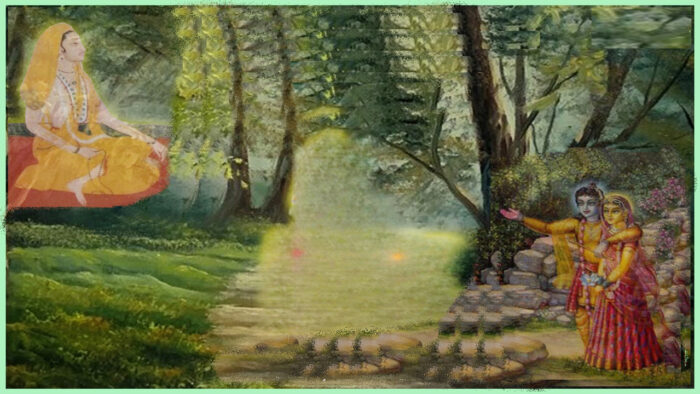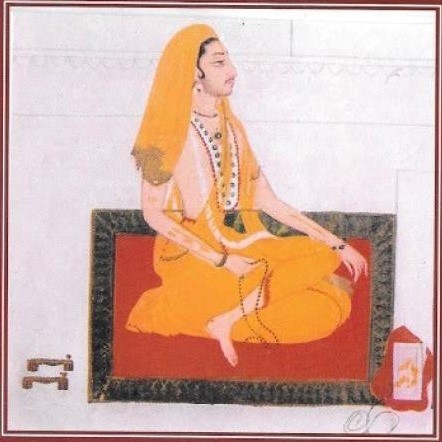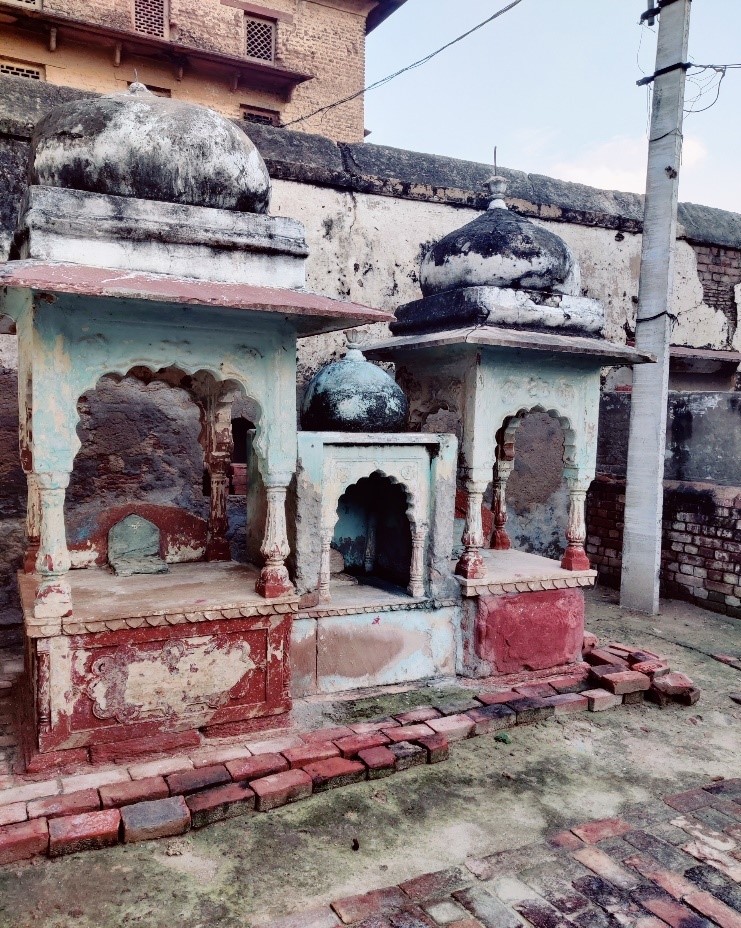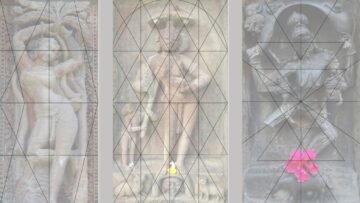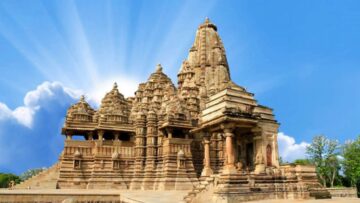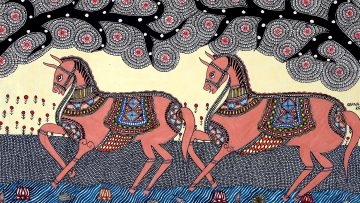Abstract
Poems are more than just expressions of a poet’s feelings. Such works often conceal a wealth of other crucial data. As an example, consider the Braj Bhasha poetry of Maharaj Sawant Singh Ji of Kishangarh alias Nagaridas, who embraced Vaishnavism later in life. His last acclaimed book, Bana Jana Prasamsha (Praise for the people of Braj), reveals important details on Vrindavan’s society in the eighteenth century.
His writings detail the several trades that were common in Vrindavan during that time. Nagaridas, having abdicated as king, returned to the temple town of Vrindavan, which had begun to develop efficiently under the then Jat domination, and found it a full-fledged town teeming with numerous occupations.
His literary art provides a clear picture of the economic climate of the town and the presence of many social groups that made up its population at the time. Nagaridas’ descriptions are remarkable because he skilfully incorporates the concept of bhakti, making every citizen of the town feel like they matter. The goal of this paper is to shed light on Nagaridas’s poetry by situating it within the political and economic climate of Vrindavan in the eighteenth century.
The literary staging of a city as a whole, as well as the attributions to and discourses about cities, can be investigated through literary representations of cities. This is especially true of the often-detailed depictions of urban settings and the diverse approaches to narrating the peculiarities of city life that can be observed in the literature. These literary depictions of city life, city space, and urban spatial systems provide a wealth of information for researchers in the fields of literature and urban planning.
Studying the distinctive and varying modes of representation and staging of one city in contrast to others can benefit urban sociology approaches. These approaches focus on the uniqueness of cities rather than adhering to long-standing paradigm of a universal urban experience or ‘the’ city in general. The study also sheds light on potentially city-specific aspects, patterns, and the unquestioned and often subconsciously operating knowledge of how things are said or done in a specific city. City-specific patterns which occur across a wide range of individual authors and texts of one city and differ sufficiently in comparison with representations of other cities, show a systematic impact instead of singular influence.
Poetry, an imperative aspect of the literature is one of the most astounding techniques that has been used to learn about a variety of previously unknown aspects of human history. It is one of the ways in which age-old practise of documenting history has been consistently upheld and sustained over the years. Poets have played a significant role throughout history in the recording of some of the most significant and important facts about the past. It has been recognized, particularly in the context of India that in some of the rare situations these poetries operate as a vital gateway for the past about which much was not known through any other available sources. This is particularly true for those instances in which these poetries were written. Poets have made significant contributions all throughout the world in the form of poetry, and these contributions have been very helpful in capturing minute facts about the past.
Since the early sixteenth century, Braj Bhasha has been one of the most important intangible aspects of the renowned region of Braj, which encompasses the modern-day district of Mathura in addition to the neighbouring regions of Rajasthan and Haryana. This aspect has contributed to a better knowledge of the history of the region. Specifically, in the city of Vrindavan, numerous poets have achieved prominent positions. These poets penned lovely couplets in Braj Bhasha, depicting the numerous characteristics of Braj Bhoomi, such as its people, culture, flora, wildlife, and other aspects. These contributions to poetry by a variety of poets have, for the most part, been spiritual in character; nonetheless, a great deal of valuable information has been embedded in the works that they have produced.
Several military wars were fought in North India in the eighteenth century. Unrest spread over all of Northern India as a result of constant attacks by the Mughals. At around the same time, the Rajputs and the Marathas rose as new political forces against the Mughals. The Rajputs have been prominent in Northern Indian politics from ancient times. They also provided financial assistance for the commissioning of holy texts, the building of temples, and the cultivation of music, dance, and other forms of the performing arts as a means of expressing Hindu beliefs. They subscribed to a broad variety of religious traditions, but because of internal struggle and fluctuations in political loyalty, their views changed often throughout the course of history. Since they were not from the countryside, they mingled with people from all over the world.
In this paper, we will focus on Kishangarh, one of the Rajput dominions in Rajputana. Among the intriguing individuals who would eventually make Vrindavan their home, some trace his origins back to this house. Kishangarh being a small Rajput principality has been known for its magnificent Radha-Krishna paintings. But it has always been more than just its stunning architecture and paintings. The Maharaja of Kishangarh at the time of Aurangzeb’s death in 1707 was Raj Singh, who ruled from 1706 to 1748. Raj Singh backed his married relative Mu’azzam Shah Alam, who succeeded Aurangzeb as Bahadur Shah, in the war for the empire that followed Aurangzeb’s death. It is believed that Raj Singh was the first king of Kishangarh to financially establish an official painting school, and it was under his reign that the school began to develop its own distinctive style of Radha-Krishna miniatures.
Savant Singh was the third among the five sons of Raj Singh. Fateh Singh, the first son of Raj Singh, passed away at an early age. The second son, Sukh Singh, rebelled against his father and was thus imprisoned for his actions. As a result, Savant Singh was able to assume his position as the state’s crown prince around the end of the 1720 CE. Savant Singh has been acclaimed for his role as the principal sponsor of the specific type of Radha-Krishna paintings that were made under his father’s dominion. This has led some art historians to speculate that Savant Singh may have had some otherworldly leanings. In spite of the fact that he was a fervent adherent, this does not tell the whole story.
Under the title of Nagaridas, he produced a sizeable body of work that honoured Radha and Krishna via the medium of poetry. It is obvious that he has always had a strong interest in bhakti from the very beginning of his existence. He went to Braj rather often when he was young. After his mother passed away and was cremated at Vrindavan in 1728, Savant Singh and his father are said to have completed a parikrama, of the surrounding area. His mother had spent her last days in Vrindavan. In the year 1730, the construction of the family residence, also known as a haveli, was completed in the area of the pilgrimage town of Vrindavan. Nagaridas used to stay at this house frequently on his travels to the Braj area; which latter came to known as Nagari Kunj.
There are conflicting accounts as to whether or not he was a connected to Vallabhites, but most accounts place him in the confinement of Nimbarka Sampradaya situated in Salemabad, not far from Kishangarh. On the occasion of a visit in 1702, it is widely believed that his mother, with the assistance of the then Nimbarkacharya, Sri Vrindavan Dev Acharya, performed a ritual (perhaps an initiation) for her young son. It is evident from different historical documents that he possessed a divine essence from an early age, which was subsequently apparent in his poetry, regardless of what theological school he followed.
(Figure 1: Credit: Brajarasik – Nagaridas alias Sawant Singh)
Savant Singh’s life took an unexpected turn in 1748. The death of his father on Vaisakh Badi 13, while Savant Singh was in Delhi, deeply devastated the prince. He did receive “Rajtilak” within a week (on Vaishakh Sudi 5), although he was doomed to fail as monarch. While Savant Singh was away, his younger brother Bahadur Singh seized the opportunity to become king. Previously, the brothers had been at odds over financial matters. Bahadur Singh complained about the sum given to Savant Singh in a letter that Savant Singh addressed to his father for guidance after being chosen to oversee Kishangarh’s finances while his father was in Delhi.
Bahadur Singh’s plan to seize power demonstrated his prowess as a thinker. There was nowhere for Savant Singh to turn to. Savant Singh normally would have been able to get support for his cause from a wide variety of people and organisations in Delhi and Rajasthan. In 1748, however, his trials paled in comparison to those of the Mughal Empire as they were facing an extreme threat by Ahmad Shah Durrani, new leader of Afghan tribes. Sawant Singh also went to ask for the help from Kacchawahas (a Rajput clan), but nothing happened.
Later in the course of the history, Kishangarh was tangentially involved in an unwanted struggle that was being waged by the Marathas in Rajasthan. With Peshwa Raghunath Rao and Dattaji Shinde in the central scene amidst an ugly family turmoil in Kishangarh house led to an intense political scene. With a peace treaty initiated by Dattaji Shinde, the kingdom was divided in half: Bahadur Singh received Kishangarh, and Sardar Singh, Savant Singh’s son, gained Rupnagar. Both of these territories were given to Savant Singh’s descendants.
After a long time, Savant Singh was successful in retaking the territory that was located around Rupnagar with the aid of the Marathas. Finally, he left for Braj in the year 1752 and sometime between Ashad and Bhadon, in the year 1764, he passed away at Vrindavan. His residence at Nagari Kunj is situated in close proximity to his Samadhi. He penned a great deal of Braj Bhasha literature, primarily poetry, before his passing, some of them are Pada Prabodh Mala (1748 CE), Rama Charita Mala (1749 CE), Jugal Bhakti Vinod (1751 CE), PhagVihar (1751 CE), Van Vinod (1752 CE), Vrindavan Abhilash Purana Pada Prabandha (1752 CE), Bal Vinod (1752 CE), Tirthanand (1753 CE), Sujan Ananda (1754 CE) and lastly Bana Jana Prasansha (1763 CE). While his whole body of work is rightfully praised and recognised for its historical significance, this paper will concentrate on his last major book, Bana Jana Prasansha.
(Figure 2: Credit: Author – Nagaridas Ji’s Samadhi at Vrindavan)
Bana Jana Prasamsha comprising of sixty Brajbhasha couplets was the last and most significant work written by Nagaridas in the backdrop of Vrindavan in the eighteenth century. Nagar Varnan, or the city description, has been a popular subject in Indian literature but unfortunately, we have not discovered any full-ledged account in the setting of Braj or Vrindavan until the seventeenth century. The scene of a bustling temple town was only sketched by a few poets in the past. We haven’t found any evidence that somebody ever did write such a thing, although it’s certainly plausible. At least in Vrindavan, Sawant Singh aka Nagaridas’s final lauded effort was a first of its kind. Vrindavan Dhamanuragavali, a lyrical depiction in Braj Bhasha poetry, was written by another Vrindavan bard named Gopal Kavi in the nineteenth century, although Nagaridas’s work is among the most important in that canon.
The Bana Jana Prasamsha, like other renowned Braj Bhasha texts, opens with a lovely Mangalcharan extolling the splendour of Vrindavan. Like many of his poetic forebears, Nagaridas places a strong emphasis on Vrindavan’s natural setting. It is noteworthy that, in the very next couplet unlike many other poets, he does not explicitly identify with any one of the several Vaishnav sects while praising his spiritual master. In the wake of Ahmad Shah Durrani’s rage in 1757, when he destroyed the temple cities of Mathura, Vrindavan, and Gokul, and in his subsequent defeat by Jat King Surajmal in the Battle of Bharatpur (1757 CE), this manuscript stands out as one of the few survivors. Thus, the book describes the various social groups, flora, and wildlife of Vrindavan during that period, in order to comment indirectly about the town’s prosperity.
The primary text may be broken down into three main categories: The spiritual class, the vocational/occupational class, and the fauna. All of the couplets begin with set of words “Dhan-Dhan” meaning “Hail, Hail” with the exception of the Mangalcharan and Pushpika couplets. The first group of verses in the poem describes the various spiritual classes in Vrindavan at the time of writing. In addition to Nagaridas’s Guru, the couplets extol the presence of saints, viraktas, sadhus, mahantas, pandits and goswamis (the spiritual leaders of many temples and ashrams). Let us talk about one of the couplets that celebrates the Viraktas of Vrindavan as an example:
धन-धनवृन्दाविपुनविरक्त।
संग्रहभजनकियोतजिसंग्रह, छाँड़िवांतज्योंजक्त।।
कृष्णकथामकरंदकेमधुकरवृत्तिआसक्त।
“नागर” फिरतछीनतनकुंजनिभयेपुष्टहरिभक्त।।
(Hail the divine presence of Viraktas who dwell in the blessed land of Vrindavan,
Those who only collect the divine name of the lord; leaving the worldly desires considering it as filthy as one’s vomit,
Those who are completely obsessed and wander in the divine land for the sweet nectar in the form of lord’s divine name,
Nagaridas says that these blessed souls have become gracious devotees after roaming in the divine land of Vrindavan.)
Nagaridas being a very lyrical writer has spared no detail in his attempt to describe the divine nature of Vrindavan’s spiritual elite. The finest aspect of Nagaridas’s testimony is that he doesn’t elaborate much on the mundane details of everyday life but rather on the saintly example he sets.
The next series of couplets describes the various social strata represented in Vrindavan during the time. Speakers, poets, singers, writers, bard, merchants, candy makers, grocery store owners, doctors, carpenters, goldsmiths, oil vendors, perfume vendors, tailors, fruit vendors, potters, cloth dyers, etc. are all lauded in the text. This is the most important component of the text since it covers a rarely covered aspect of Vrindavan. While much is written about Mathura, a historic city and commercial hub, little is known about Vrindavan’s economy, despite the fact that it is only a short distance away. The work of Nagaridas is the first of its kind, providing a comprehensive catalogue of the numerous professions represented in the holy city of Vrindavan. Nagaridas’ beautiful depiction evokes the wealth and economic prosperity of Vrindavan in the eighteenth century. Here is one beautiful couplet by the poet in the praise of the Goldsmiths dwelling in Vrindavan:
धन-धनवृन्दावनकेसुनार।
जुगलरूपसेवाकेभूषनदेतहैंसदासँवार।।
काजयहाँकोबड़भागनतैं, दयोतिन्हेंकरतार।
“नागरीदास” बसततहाँतिनकी, महिमाकोनहिपार।।
(Hail the divine presence of Goldsmiths who dwell in the blessed land of Vrindavan,
Those who are always dedicated in the service of the divine couple by making beautiful ornaments for them,
Those who are blessed by the almighty themselves; who has bestowed such beautiful service in their hands,
Nagaridas says what can be said about the fortune and blessings of these Goldsmiths, even words fall short in their praise.)
Nagaridas’s love for Vrindavan is perfectly encapsulated in the final pair of couplets. In these verses, he describes the fauna, the avian residents of Vrindavan. While most Braj Bhasha poetry focuses on praising cows and peacocks because of their significance to Krishna’s life, Nagaridas goes farther by attributing divine status to the Vrindavan-based creatures who inhabit the region. Cows, monkeys, dogs, cats, crows, etc. are just few of the animals he sings the virtues of. To explain further let us see how Nagaridas explains the divinity of a dog in Vrindavan:
धन-धनवृन्दावनकेस्वान।
संतसीतकीकरेंजीविकाजमुनाजलकोपान।।
कुंजद्वारचौकीमेंचौकसइहिरजकरतसनान।
“नागरिया” जेविमुखमनुषहैंतेइनकेनसमान।।
(Hail the divine presence of Dogs who dwell in the blessed land of Vrindavan,
Those who eat the leftovers of the highly elevated Saints and drink the sublime water of Yamuna,
Those who guard the highly revered gates of Kunj and take bath in the pious sand of Vrindavan
Nagaridas says one should consider themselves, but not them as dogs who wander for material desires in this world.)
Even in his heavenly trance, Nagaridas was aware enough to provide specific information about every citizen of Vrindavan, from the most exalted saints to the ordinary dogs. The work of Nagaridas is one of the greatest surviving descriptions from that time period, and it tells us of a temple town that was repeatedly attacked and then abandoned. One of the most important touchstones of the historical narratives for one of the most cherished pilgrimage places in northern India is Nagaridas’s contribution in shaping Braj Bhasha literature.
Conclusion
In order to construct a historical narrative about a particular area or person, academia in and outside India have traditionally avoided using vernacular texts. Vernacular writings are typically forced to address numerous unimportant questions, whereas foreign narratives are often given a free pass without any examination. Many Braj Bhasha writings have suffered from this problem for centuries, with academics unable to fully realise their potential. They are often dismissed as poetry or fiction, and as a result, never emerge from the shadows of prejudice and bias. Vernacular texts like Bana Jana Prasamsha have been largely ignored by academics in our country too, but they hold the key to deciphering a historical sketch that can help current and future historians carve out new approaches in a field dominated by Western methods. As a result, it is crucial that the next generation of researchers, historians, and academics pay attention to this vital part of India’s literary heritage and take steps to preserve it before it is too late.
Watch video presentation of the above paper here:
Disclaimer: The opinions expressed in this article belong to the author. Indic Today is neither responsible nor liable for the accuracy, completeness, suitability, or validity of any information in the article.

